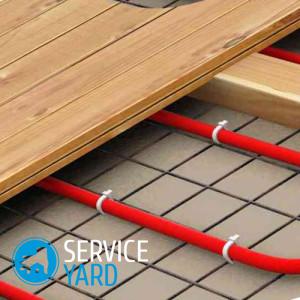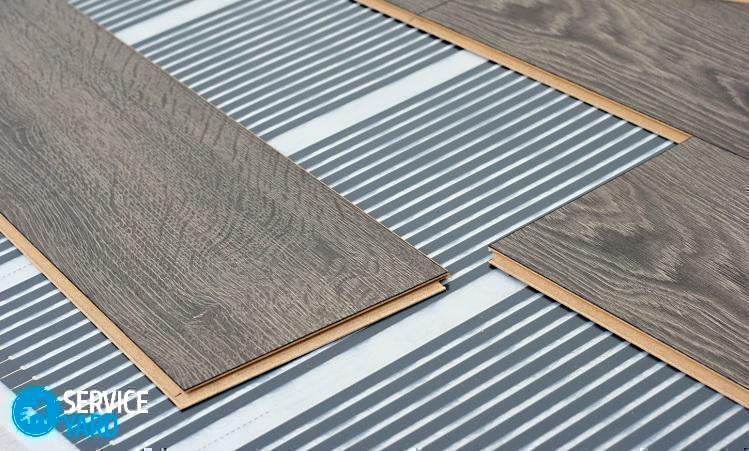Laying underfloor heating under the laminate

- Method selection
- Types of flooring under the laminate, advantages
- The necessary set of materials
- Installing a film underfloor heating under the laminate - useful tips:
- How to prepare the foundation?
- Insulation layer
- Installation of infrared underfloor heating under the laminate
- Connection of wires, installation of a temperature regulator
- System testing
- Stock footage
Arrangement of home heating is one of the most important issues, which must be taken very seriously, because the microclimate in the rooms in the cold season depends on the quality of heating. Warm floors have long ceased to be something exotic and elitist. For many people this is a necessity. Laying a warm floor under the laminate is a rather urgent issue. One of the most effective and economical methods is the use of film insulation under the floor covering. The method is also good because it does not require any preliminary preparation. In addition, it is very reliable. The cable is replaced by a special thermal film.
to contents ↑Method selection
There are such technologies for laying insulated floors:
- Thermal film under the floor.
- Installation of a heat-insulated floor in a coupler with the subsequent laying of a layer of a laminate.
- Arrangement of underfloor heating for tiles in the upper part of the screed.
to contents ↑Important! Thermofilm placed directly under the coating is a good way if you do not need to change the screed. The underfloor heating layer is used in the kitchen, in the bathroom or on the balcony. A waterproofing layer is laid at the base of the structure, and a thin layer of screed is placed on top.
Types of flooring under the laminate, advantages
If until recently, few people knew about the existence of infrared warm floors, today they are megapopular.
The principle of operation of this heating system is infrared radiation, which is completely safe for laminate and wooden coatings. There are 2 types of film underfloor heating:
- Bimetallic. This is the thinnest polyurethane film with an embedded two-layer connection. The top layer is a copper alloy, the bottom is aluminum.
- Carbon. This is a film of 2 dacron layers with thermal elements.
Important! Carbon films are used to warm not only floors, but also walls. It is elastic, and its dimensions (585x545 mm) make it very convenient to install.
Advantages of infrared film floors:
- Simple and extremely quick installation (no more than 2 hours).
- Small thickness (3 mm), which does not “eat up” the height of the room.
- High degree of reliability.
- There is no need to fill the screed, since the insulation is perfectly placed under the laminate, linoleum and carpet.
- Hypoallergenicity.
- Simple dismantling (for example, in case of moving), which makes it possible to save money and not to buy a new insulation.
- Ionizing effect.
The necessary set of materials
The standard kit for a warm film floor includes:
- Roll wrapped thermal film.
- Contact clamps.
- A set of wires.
In addition, you need to purchase a temperature indicator and a temperature controller. To equip the insulation, you will need such materials:
- Polyethylene film.
- Construction adhesive tape (single or double sided).
- Material with heat reflecting properties.
Installing a film underfloor heating under the laminate - useful tips:
- Installation work is carried out at a positive air temperature and humidity level not exceeding 60%.
- You cannot connect minimized film to the network.
- It is not permissible to lay the underfloor heating system on a damp surface.
- In case of accidental flooding, disconnect the system from the power supply and dry it.
- Do not walk in shoes on an already mounted floor.
- Do not wrap the temperature sensor so that it can be replaced.
How to prepare the foundation?
When installing a film-type insulation, it is not necessary to dismantle the old coating. Dismantling is carried out only if it is too shabby and worn out. If the coating is in good condition, then it is enough to clean it from contamination. Before laying a film underfloor heating under the laminate, check with a building level how smooth the surface is. All detected irregularities must first be aligned.
to contents ↑Important! The area intended for placement of furniture or household appliances is not insulated, since this is impractical. It makes sense to insulate the entire room only if frequent furniture changes or renovations are planned.
Insulation layer
The purpose of waterproofing is to protect the insulation layer from moisture. The next layer behind waterproofing is thermal insulation. It is designed to minimize heat loss. If the thermal insulation is made qualitatively, then the efficiency of the system becomes much higher.
Joints are glued with adhesive tape with a metallized coating.
Important! When installing a film underfloor heating under a laminate, it is best to use a 3-mm foam material with a lavsan reflective coating as a heat insulator. Foil coating for infrared insulation of floors is not practical enough, so experts do not recommend it.
Using a thermostat, temperature is controlled:
- Setting its basic value.
- Setting the heating frequency.
- Automate system on and off.
to contents ↑Important! The optimal height of the thermostat in relation to the floor is 20 cm.
Installation of infrared underfloor heating under the laminate
Here are the economical options for film floors:
- 50% of the room area, at the rate of 90-150 W / m2 - if floor heating plays an auxiliary role.
- 70-80% of the area, per 1 “square” of 150 watts of power - if underfloor heating plays a major role in heating, and there are no other sources of space heating.
Important! The minimum interval of thermal film from the walls is 200 mm. Do not place the heater closer than 1000 mm from the fireplace or other powerful heating device.
In order to properly decompose the thermal film, in accordance with a pre-compiled diagram, it is cut accordingly. The maximum length of the segment is 8 m.
Important! Do not overlap parts of the insulation.
The film is single and double-sided:
- The single-sided film is mounted with the reinforced side down.
- Double-sided material can be laid as you wish.
After laying the material, clamps are attached to the copper strip, and wires are attached to them. Cut off parts of the film with exposed copper parts are insulated to prevent damage. The best option is bitumen insulation. In places of fastening wires, insulation is not needed.
to contents ↑Connection of wires, installation of a temperature regulator
Here are the basic rules for connecting this part of the system:
- Wires extend from the center to the walls.
- The wiring is mounted under the thermal film into the holes made.
Important! It is unacceptable that the wires protrude beyond the insulating layer.
- The connection to the clamps is parallel.
- A thermal sensor is mounted to the underside of the heating film. It must be well insulated. This is a kind of temperature measuring device with a head made of a polymer material.
- The temperature regulator is mounted after the temperature sensor and connecting wires are mounted.
- It is possible both stationary installation and using a power outlet.
- Grounding wires are connected using a terminal.
System testing
It is made before the start of operation of the heating system.The absence of overheating of individual sections and sparking suggests that all work on installing a warm floor under the laminate was performed correctly.
If there are no defects, then a plastic film is laid on top of the heating system (minimum thickness 80 μm). It protects the thermal film from accidental ingress of water.
to contents ↑Stock footage
Laminate should be laid very carefully to prevent damage to the thin film. You need to choose a floor covering with a special marking “installation under a warm floor is possible”. The heating system must not be switched on immediately. You need to wait until it warms up to room temperature. That's it. Installation of underfloor heating under the laminate is over.
- How to choose a vacuum cleaner taking into account the characteristics of the house and coatings?
- What to look for when choosing a water delivery
- How to quickly create comfort at home - tips for housewives
- How to choose the perfect TV - useful tips
- What to look for when choosing blinds
- What should be running shoes?
- What useful things can you buy in a hardware store
- Iphone 11 pro max review
- Than iPhone is better than Android smartphones




